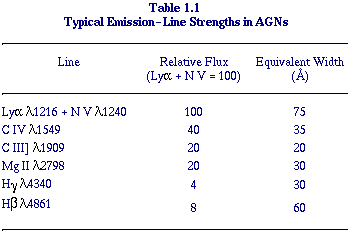

© CAMBRIDGE UNIVERSITY PRESS 1997
| |
1.3.4 Broad Emission Lines
The UV-optical spectra of quasars are distinguished by strong, broad
emission lines. The strongest observed lines are the hydrogen
Balmer-series lines (H
 6563, H
6563, H
 4861, and H
4861, and H
 4340), hydrogen Ly
4340), hydrogen Ly
 1216, and prominent lines of abundant ions (Mg II
1216, and prominent lines of abundant ions (Mg II  2798, C III]
2798, C III]  1909,
and C IV
1909,
and C IV  1549); these lines
appear in virtually all quasar spectra, but
depending on the redshift of the quasar, some may not be observable if
they fall outside the spectral window of a particular
detector. Typical flux ratios are given in
Table 1.1, along with
typical equivalent widths, defined by
1549); these lines
appear in virtually all quasar spectra, but
depending on the redshift of the quasar, some may not be observable if
they fall outside the spectral window of a particular
detector. Typical flux ratios are given in
Table 1.1, along with
typical equivalent widths, defined by
where F1(
where Fline is the total line flux, usually in units
of ergs s-1 cm-2.
The correct interpretation of emission-line equivalent widths is
that they provide an estimate of how large a continuum range one would
need to integrate over to obtain the same energy flux as is in the
emission line. This is especially relevant in the context of
broad-band photometry of quasars; for example, if we compare the
colors of high-redshift quasars, we find that the U band is greatly
enhanced for quasars with z

 )
is the observed flux across the emission line at the
wavelength
)
is the observed flux across the emission line at the
wavelength  , and
Fc(
, and
Fc( ) is the
continuum level underneath the emission
line. Both of these quantities are specific fluxes that are
conventionally measured in units of ergs s-1 cm-2
Å-1, so the
equivalent width is measured in ångströms.
1 It is nearly always
sufficient to approximate eq. (1.9) by
) is the
continuum level underneath the emission
line. Both of these quantities are specific fluxes that are
conventionally measured in units of ergs s-1 cm-2
Å-1, so the
equivalent width is measured in ångströms.
1 It is nearly always
sufficient to approximate eq. (1.9) by


 2, since the Ly
2, since the Ly emission line then
falls in the U band and alone attributes more than ~ 12% (
emission line then
falls in the U band and alone attributes more than ~ 12% ( W
W (Ly
(Ly ) / W (U), where
W (U)
) / W (U), where
W (U)  680 Å, the
width of the U bandpass) of the
flux in the band. This means that in a flux-limited sample, quasars
with strong emission lines in a given bandpass are more likely to be
detected, which can thus lead to the erroneous conclusion that there
are excess quasars at particular redshifts; we will return to this
topic in Chapter 10.
680 Å, the
width of the U bandpass) of the
flux in the band. This means that in a flux-limited sample, quasars
with strong emission lines in a given bandpass are more likely to be
detected, which can thus lead to the erroneous conclusion that there
are excess quasars at particular redshifts; we will return to this
topic in Chapter 10.
1 X-ray fluxes are sometimes given in units
like photons s-1 cm-2 keV-1, so
equivalent widths of X-ray lines are given in keV.
Back.